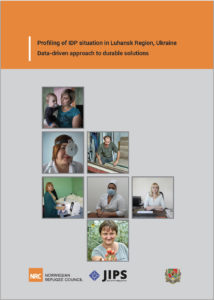 The Luhansk State Regional Administration and Norwegian Refugee Council (NRC) jointly decided to improve the understanding of future intentions and plans of IDPs, obstacles faced in pursuing durable solutions, as well as vulnerabilities and coping strategies with regard to housing, land and property, access to livelihoods, employment, and social services. JIPS was requested to provide technical support, specifically for the creation of the interagency technical working group and the development of methodology and tools.
The Luhansk State Regional Administration and Norwegian Refugee Council (NRC) jointly decided to improve the understanding of future intentions and plans of IDPs, obstacles faced in pursuing durable solutions, as well as vulnerabilities and coping strategies with regard to housing, land and property, access to livelihoods, employment, and social services. JIPS was requested to provide technical support, specifically for the creation of the interagency technical working group and the development of methodology and tools.
The profiling was in part motivated by the lack of reliable data on the numbers and conditions of IDPs in the region and the ongoing discrepancy between official IDP statistics and the need to ensure data-driven, evidence-based decision making. The profiling was launched in 2019 and lasted through summer 2020 with the data collection having concluded before the outbreak of the Covid-19 pandemics.
The profiling was conducted in five urban locations in Luhansk region: Severodonetsk, Lysychansk, Starobilsk, Rubizhne and Kreminna. The collected data paint a profile of urban IDPs in Luhansk region as predominantly work-aged IDP population mostly displaced from urban areas in the non-government controlled areas (NGCA), more likely females and university graduates with not-so-well paid full-time jobs, living in rented accommodation in small household units. The profiling confirmed the generally known main challenges to durable solutions as adequate housing, be it return, repeated displacements or settlement in another part of the country.
—
JIPS’ technical support on durable solutions analysis to the Luhansk State Regional Administration and NRC was made possible thanks to the generous contribution from our donors, particularly the United States Government and the Directorate-General for European Civil Protection and Humanitarian Aid Operations (DG-ECHO).